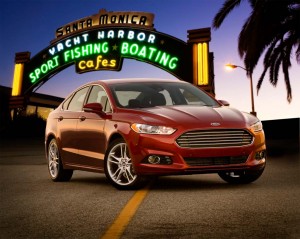
Can you afford this 2013 Ford Fusion -- or any other typical 2013 model? Maybe not, finds a new study.
Looking to buy a new car, truck or crossover? You may find it more difficult to stretch the household budget than you expected, according to a new study that finds median-income families in only one major U.S. city actually can afford the typical new vehicle.
The typical new vehicle is now more expensive than ever, averaging $30,500 in 2012, according to TrueCar.com data, and heading up again as makers curb the incentives that helped make their products more affordable during the recession when they were desperate for sales.
According to the 2013 Car Affordability Study by Interest.com, only in Washington, D.C. could the typical household swing the payments, the median income there running $86,680 a year. At the other extreme, Tampa was at the bottom of the 25 large cities included in the study, with a median household income of $43,832.
The study looked at a variety of household expenses, such as food and housing, and when it comes to purchasing a new vehicle, it considered more than just the basic purchase price, downpayment and monthly note, factoring in such essentials as taxes and insurance.
Bottom line? A buyer in the capital can purchase a car with a sticker price of $31,940, slightly more than the new vehicle average for the 2013 model-year and about what it would cost for a mid-range Ford Fusion sedan or a stripped-down BMW X1 crossover. The buyer in Tampa? They’ll just barely cover the cost of a basic Kia Rio, with $14,516 to spend.
“If you live in New York City or San Francisco, you’re probably going to have to pay a lot for housing, but you don’t have to pay a lot for a car,” said Mike Sante, the managing editor of Interest.com, a financial decision-making website.
(Yes, you’re likely paying more for that new 2013 model. Click Here for more.)
Affordability has been a matter of growing concern for the auto industry in recent years as prices have continued to move upward. Even the most basic of today’s cars are generally loaded with features that were once found on high-line models a few decades back – if they were available at all – such as air conditioning, power windows, airbags and electronic stability control, as well as digital infotainment systems. They also have to meet ever tougher federal safety, emissions and mileage standards that have added thousands to the typical price tag.
“The average compact car of today has the features of a midsize model somebody might be trading in – but it may be just as expensive,” noted David Sargent, director of automotive operations for J.D. Power and Associates.
That is one reason why many buyers have been downsizing in recent years, acknowledged Bill Fay, general manager of Toyota, though he insisted “There is still a lot of affordability in the marketplace.”
Perhaps, but industry planners have come to recognize that they are targeting a much smaller segment of the American public than in decades past. That’s one reason why most manufacturers are offering more downsized models.
They also are working with their dealers to offer certified pre-owned programs where buyers can stretch their budget by purchasing a two or three-year-old vehicle that has gone through an extensive inspection and, if necessary, repairs and replacements. Such vehicles may cost slightly more than a conventional used model but usually include a like-new warranty.
While the typical new vehicle will likely nudge up and possibly over the $30,000 mark this year, Interest.com editor Sante stressed that “Car costs are one of the most controllable parts of a household’s budget,” adding that, “You’re better off driving something more affordable and saving or investing the difference.”
If the typical new car costs $30,550, with an average monthly payment of $550, the five cities most able to meet – or come close – are:
1) Washington, D.C., average Household Income, or HHI, of $86,680, and an Affordable Purchase Price, or APP, of $31,940, which works out to a maximum monthly payment of $628 a month.
2) San Francisco, HHI of $71,975, APP of $26,786, and a maximum monthly payment of $537.
3) Boston, HHI of $69.455, APP of $26,025, and a maximum monthly payment of $507.
4) Baltimore, HHI of $65,463, APP of $24,079 and a maximum monthly payment of $468.
5) Minneapolis, HHI of $63,352, APP of $24,042, and a maximum monthly payment of $470.
At the other end of the scale, those five cities least able to handle a car payment are:
21) Phoenix, HHI of $50,058, APP of $17,243 and a maximum monthly payment of $348.
22) San Antonio, HHI of $48,699, APP of $17,137 and a maximum monthly payment of $334.
23) Detroit, HHI of $48,968, APP of $17,093, and a maximum monthly payment of $332.
24) Miami, HHI of $45,407, APP of $15,188, and a maximum monthly payment of $295.
25) Tampa, HHI of $43,832, APP of $14,516 and a maximum monthly payment of $282.
You can find out more by going to this link at Interest.com.

Politicians have no problem affording new cars…